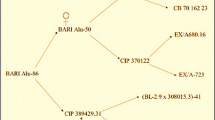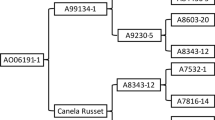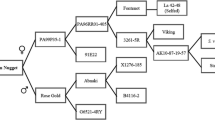Abstract
TerraRossa (POR01PG20–12) is a mid-season specialty potato, released by Oregon State University, and is a product of the Northwest Potato Variety (Tri-State) Development Program. This cultivar is unique among commercially available potato cultivars in that plants produce small- to medium-sized smooth, oblong- to long-shaped tubers with red skin and red flesh. Total tuber yields of TerraRossa are similar to Dark Red Norland and less than Red La Soda. Average tuber size (136 g) is less than both of the comparison cultivars, reflecting inherent differences in tuber size distribution. TerraRossa tubers have total antioxidant levels higher than traditional white fresh varieties and comparable to the All Blue purple potato, known for its high antioxidant levels. Sensory evaluations of TerraRossa tubers indicated that it has good culinary attributes following boiling, baking, and microwaving. Potato chips made from TerraRossa tubers retained their unique red color, which represents a novelty in the chipping industry. TerraRossa could be a good candidate for the organic sector due to its tolerance to common scab (Streptomyces scabies) and tuber late blight (Phytophthora infestans) and its resistance to golden cyst nematode (Globodera rostochiensis). Due to its high yields, high chipping quality, good culinary properties, high antioxidant content and disease resistance, TerraRossa is a good candidate for opening new specialty type markets, adding diversity to the marketplace.
Resumen
TerraRossa (POR01PG20–12) es una papa de especialidad de ciclo intermedio, liberada por la Universidad del Estado de Oregon, y es un producto del Programa de Desarrollo de Variedades de Papa Noroccidental (Tri-State). Esta variedad es única entre las variedades de papa disponibles comercialmente, en el sentido de que las plantas producen tubérculos de tamaño pequeño a mediano, suaves, de formas oblongas a alargadas, de piel y pulpa rojas. Los rendimientos totales de tubérculo de TerraRossa son similares a Dark Red Norland y menores a los de Red La Soda. El tamaño promedio del tubérculo (136 g) es menor al de ambas variedades de comparación, reflejando diferencias inherentes a la distribución del tamaño de tubérculo. Los tubérculos de TerraRossa tienen niveles totales de antioxidantes más altos que las variedades tradicionales de pulpa blanca y comparables a la papa morada All Blue, conocida por sus altos niveles de antioxidantes. Las evaluaciones sensoriales de los tubérculos de TerraRossa indicaron que tiene buenos atributos culinarios después de hervidas, cocinadas y pasadas por el horno de microondas. Las hojuelas de papa hechas de los tubérculos de TerraRossa retienen su color rojo único, que representa una novedad en la industria del freído. TerraRossa pudiera ser una buena candidata para el sector orgánico debido a su tolerancia a la roña común (Streptomyces scabies), al tizón tardío de tubérculo (Phytophthora infestans) y su resistencia al nematodo dorado de quiste (Globodera rostochiensis). Debido a sus altos rendimientos, alta calidad de freído, buenas propiedades culinarias, alto contenido de antioxidantes y resistencia a enfermedades, TerraRossa es una buena candidata para abrir nuevos mercados del tipo de especialidades, agregando diversidad al ámbito del mercado.




Similar content being viewed by others
References
Akeley, R.V., W.R. Mills, C.E. Cunningham, and J. Watts. 1968. Lenape: A new potato variety high in solids and chipping quality. American Potato Journal 45: 142–145. https://doi.org/10.1007/bf02863068.
Bakker, E., U. Achenbach, J. Bakker, J. Vliet, J. Peleman, B. Segers, S. Heijden, P. Linde, R. Graveland, R. Hutten, H. Eck, E. Coppoolse, E. Vossen, J. Bakker, and A. Goverse. 2004. A high-resolution map of the H1 locus harbouring resistance to the potato cyst nematode Globodera rostochiensis. Theoretical and Applied Genetics 109: 146–152.
Bali, S., V. Sathuvalli, C. Brown, R. Novy, L. Ewing, J. Debons, D. Douches, J. Coombs, D. Navarre, J.L. Whitworth, B.A. Charlton, S. Yilma, C.C. Shock, J.C. Stark, M.J. Pavek, and N.R. Knowles. 2017. Genetic fingerprinting of potato varieties from the northwest potato variety development program. American Journal of Potato Research 94: 54–63. https://doi.org/10.1007/s12230-016-9547-z.
Brand-Williams, W., M.E. Cuvelier, and C. Berset. 1995. Use of a free radical method to evaluate antioxidant activity. Lebensmittel-Wissenschaft und -Technologie 28: 25–30.
Brown, C.R., I. Vales, S. Yilma, S. James, B. Charlton, D. Culp, D. Hane, C. Shock, E. Feibert, M. Pavek, R. Knowles, R. Novy, J. Whitworth, J. Stark, J.C. Miller Jr., D. Holm, R. Quick, and R. Navarre. 2012. “AmaRosa,” a red skinned, red fleshed fingerling with high phytonutrient value. American Journal of Potato Research 89: 249–254. https://doi.org/10.1007/s12230-012-9248-1.
Cunningham, C.E., R.V. Akeley, L.C. Peterson, and T.E. Snyder. 1968. Wauseon: A new potato variety resistant to golden nematode with good processing quality. American Potato Journal 45: 146–149.
European and Mediterranean Plant Protection Organization. 2018. EPPO Global Database: Globodera rostochiensis. [updated 5 April 2018]. https://gd.eppo.int/taxon/HETDRO/distribution Accessed 18 May 2018.
Fontenot, J.F., W.A. Young, A. Fennell, P.W. Wilson, H. Brewer, D.W. Newson, J.E. Boudreaux, R.G. Shaver. 1993. Fontenot, a widely adapted red-skinned potato. Louisiana agriculture-Louisiana Agricultural Experiment Station v. 36.
Johansen, R.H., B. Farnsworth, J.E. Huguelet, D.C. Nelson, and E.P. Lana. 1977. Bison, a new red-skinned potato variety. American Potato Journal 54: 189–193.
Kalita, D., and S.S. Jayanty. 2017. Nutrient composition of continuous and kettle cooked potato chips from three potato cultivars. Current Research in Nutrition and Food Science 5: 75–88.
Karaagac, E., S. Yilma, and M.I. Vales. 2010. SSR-based DNA fingerprinting of potato clones from the Pacific northwest potato variety development program. Acta Horticulturae (859): 121–127. https://doi.org/10.17660/ActaHortic.2010.859.14.
Karaagac, E., S. Yilma, A. Cuesta-Marcos, and M.I. Vales. 2014. Molecular analysis of potatoes from the Pacific northwest tri-state variety development program and selection of markers for practical DNA fingerprinting applications. American Journal of Potato Research 91: 195–203. https://doi.org/10.1007/s12230-013-9338-8.
Park, J., H. Yang, W.S. De Jong, and X. Wang. 2018. An evaluation of two H1-linked markers and their suitability for selecting Globodera rostochiensis resistant potatoes in the New York breeding program. American Journal of Potato Research 95: 170–177. https://doi.org/10.1007/s12230-017-9623-z.
Pavek, M.J., and N.R. Knowles. 2018. WSU potato cultivar yield and postharvest quality evaluations for 2016. Washington State University special report. 102 pages. http://potatoes.wsu.edu/wp-content/uploads/2018/01/2017-WSU-Potato-Cultivar-Annual-Report-Researchers-Edition.pdf Accessed 24 Mar 2018.
Plaisted, R.L., D.E. Halseth, J.B. Sieczka, S.A. Slack, H.D. Thurston, R. Loria, B.B. Brodie, G.A. Porter, and E.S. Plissey. 1990. Allegany: A late season golden nematode resistant variety. American Potato Journal 67: 227–231. https://doi.org/10.1007/bf02987263.
Plaisted, R.L., D.E. Halseth, B.B. Brodie, S.A. Slack, J.B. Sieczka, B.J. Christ, K.M. Paddock, and M.W. Peck. 1998. Pike: A full season scab and golden nematode resistant chipstock variety. American Journal of Potato Research 75: 117–120. https://doi.org/10.1007/bf02895845.
Sathuvalli, V., C.R. Brown, S. Yilma, B.A. Charlton, C.C. Shock, R. Quick, E.B.G. Feibert, J.L. Whitworth, R.G. Novy, J.C. Stark, M.J. Pavek, N.R. Knowles, R.A. Navarre, J. Debons, and M.I. Vales. 2016. Yukon Nugget: A mid-season yellow skin, yellow flesh specialty potato with extreme resistance to potato virus X. American Journal of Potato Research 93: 602–608. https://doi.org/10.1007/s12230-016-9540-6.
Weaver, W.W. 2000. 100 vegetables and where they came from. Chapel Hill: Algonquin Books.
Webb, R.E., D.R. Wilson, J.R. Shumaker, B. Graves, M.R. Henninger, J. Watts, J.A. Frank, and H.J. Murphy. 1978. Atlantic: A new potato variety with high solids, good processing quality, and resistance to pests. American Potato Journal 55: 141–145. https://doi.org/10.1007/bf02852087.
Weigle, J.L., A.E. Kehr, R.V. Akeley, and J.C. Horton. 1968. Chieftain: A red-skinned potato with attractive appearance and broad adaptability. American Potato Journal 45: 293–296.
Whitworth, J.L., R.G. Novy, J.C. Stark, S.L. Love, M.K. Thornton, B.A. Charlton, S. Yilma, N.R. Knowles, M.J. Pavek, X. Wang, and J.A. Pavek. 2014. Huckleberry Gold: A specialty market potato cultivar with purple-skin, yellow-flesh, high tuber antioxidants, and resistance to potato cyst nematode (H1) and potato virus X (Nb and Rx1). American Journal of Potato Research 91: 447–458. https://doi.org/10.1007/s12230-014-9368-x.
Yilma, S., B.A. Charlton, C.C. Shock, D.C. Hane, S.R. James, A.R. Mosley, K.A. Rykbost, E.B.G. Feibert, N.R. Knowles, M.J. Pavek, J.C. Stark, R.G. Novy, J.L. Whitworth, J.J. Pavek, D.L. Corsini, T.L. Brandt, N. Olsen, C.R. Brown, M.I. Vales, and V. Sathuvalli. 2017. Sage Russet: A new high yielding russet potato variety with cold-sweetening resistance, high vitamin C and protein contents and excellent fresh pack and processing potential. American Journal of Potato Research 94: 379–389. https://doi.org/10.1007/s12230-017-9573-5.
Acknowledgements
The authors thank Margaret Bain, Darrin Culp, Lorie Ewing, and Brian Schneider, as well as our cooperators in the Western Regional Potato Variety Trials. The authors further extend their thanks to Drs. Rob Davidson and Walter De Jong for help with disease data. The contributions from the Oregon, Washington and Idaho Potato Commissions to the development and release of TerraRossa are greatly appreciated. The development of TerraRossa was partially funded by the USDA NIFA Special Grant for Potato Breeding.
Author information
Authors and Affiliations
Corresponding author
Additional information
C. R. Brown, D. C. Hane, K. A. Rykbost, S. R. James, and A. R. Mosley are retired.
Rights and permissions
About this article
Cite this article
Shock, C.C., Brown, C.R., Sathuvalli, V. et al. TerraRossa: A Mid-Season Specialty Potato with Red Flesh and Skin and Resistance to Common Scab and Golden Cyst Nematode. Am. J. Potato Res. 95, 597–605 (2018). https://doi.org/10.1007/s12230-018-9667-8
Published:
Issue Date:
DOI: https://doi.org/10.1007/s12230-018-9667-8




